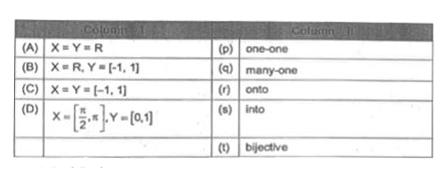Let f:X→Y be a function defined by f(x) = a sin ( x +π4) + b cosx + c. If f is both one-one and onto, then find the set X and Y
The correct Answer is:X∈[−π2−α,π2−α] and Y∈[c−r,c+r], where α=tan−1(α+b√2a) and r=√a2+√2ab+b2
Step by step video & image solution for Let f: X rarr Y be a function defined by f(x) = a sin ( x +pi/4) + b cosx + c. If f is both one-one and onto, then find the set X and Y by Maths experts to help you in doubts & scoring excellent marks in Class 12 exams.
Updated on:21/07/2023Topper's Solved these Questions
- FUNCTIONSBOOK - ARIHANT MATHS ENGLISHCHAPTER - FUNCTIONSEXERCISE - Exercise For Session 9
10 Videos
- FUNCTIONSBOOK - ARIHANT MATHS ENGLISHCHAPTER - FUNCTIONSEXERCISE - Exercise For Session 10
5 Videos
- FUNCTIONSBOOK - ARIHANT MATHS ENGLISHCHAPTER - FUNCTIONSEXERCISE - Exercise For Session 7
5 Videos
- ESSENTIAL MATHEMATICAL TOOLS BOOK - ARIHANT MATHS ENGLISHCHAPTER - ESSENTIAL MATHEMATICAL TOOLS EXERCISE - Exercise (Single Integer Answer Type Questions)
3 Videos
- GRAPHICAL TRANSFORMATIONSBOOK - ARIHANT MATHS ENGLISHCHAPTER - GRAPHICAL TRANSFORMATIONSEXERCISE - Exercise (Questions Asked In Previous 13 Years Exam)
10 Videos
Similar Questions
Let f:X→Y be a function defined by f(x)=sinx.

View SolutionLet f:R→R be a function defined by f(x)=x3+x2+3x+sinx. Then f is
View SolutionLet f:R→R be a function defined by f(x)=x3+x2+3x+sinx. Then f is
View SolutionLet f:R→B, be a function defined f(x)=tan−1.2x√3(1+x2), then f is both one - one and onto when B, is the interval
View SolutionLet f:A→B be a function defined by f(x)=√3sinx+cosx+4. If f is invertible, then
View SolutionLet the function f:R→R be defined by f(x)=cosx,∀x∈R. Show that f is neither one-one nor onto.
View SolutionLet the function f:R→R be defined by f(x)=cosx,∀x∈R. Show that f is neither one-one nor onto.
View SolutionLet the function f:R→R be defined by f(x)=cosx,∀x∈R. Show that f is neither one-one nor onto
View SolutionLet A = R - {2}, B = R - {1}. If f : A→B is a function defined by f(x) = x−1x−2, show that f is one-one and onto.
View SolutionLet f:R→R be a function defined by f(x)=x−mx−n, where m≠n. Then show that f is one-one but not onto.
View Solution
